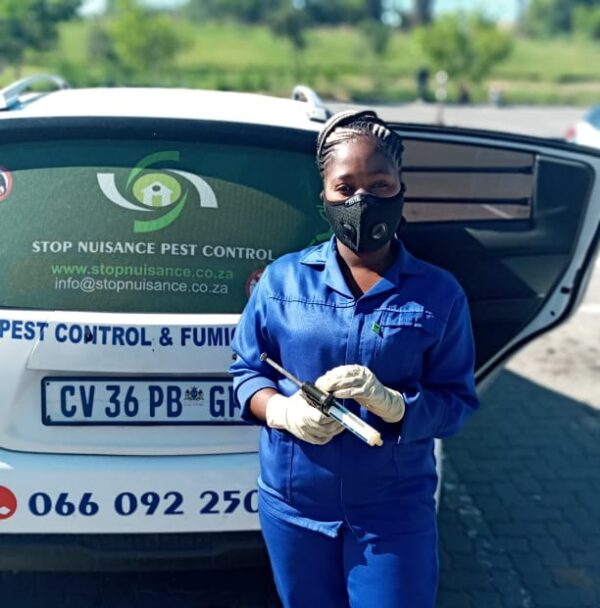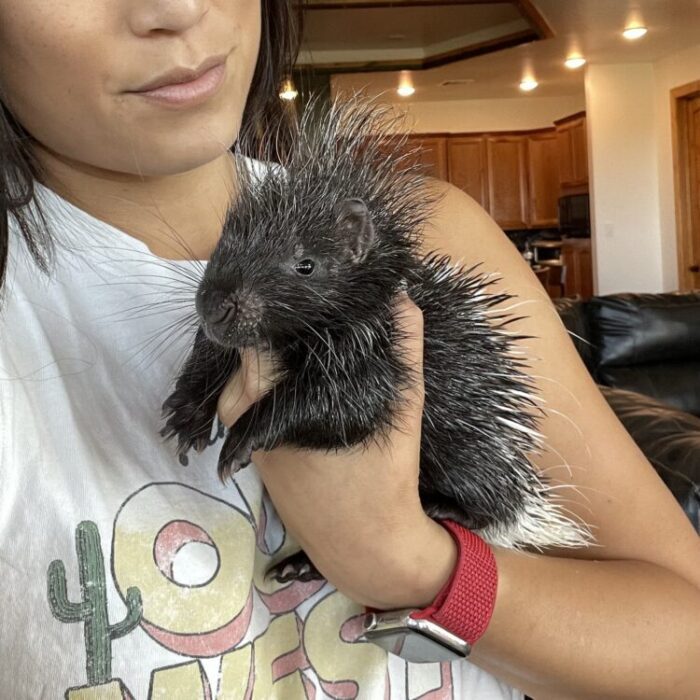Yes, porcupines like the North American porcupines can be tamed, and a number of states allow you to keep one as a pet.
They are not popular as pets because of their quills but are docile animals and will show affection to humans when fed and tamed.
Table of Contents
Is safe to Own a Porcupine?
The answer is definitely YES! Porcupines are usually docile creatures, and especially when taken young will tame down easily. Once they get used to having humans around, they can stop the erection of the quills and can easily be petted (just don’t rub them the wrong way!).
In the wild, porcupines use their quills only for self-defense and are usually gentle animals.
ALSO SEE: Can Porcupines Float and Swim?
Can You Tame A Porcupine?
The answer is definitely YES! Porcupines are not known to chase and attack people or other animals. They mind their own business, however; they do attack when provoked and threatened.
A porcupine becomes tamed when fed by humans for a long time. The younger it is, the quicker it gets tamed; even allowing you to pet it.
Are Porcupines Dangerous?
Porcupines are naturally docile creatures. However, they will raise their quills in self-defense if attacked or threatened.
Contrary to popular belief, porcupines can’t “shoot” their quills, so the only way that you’ll get jabbed is if you handle them improperly.
What Do Porcupines Eat?
Porcupines are herbivores, so you’ll need to provide them with a consistent diet of vegetables and fruits. In the wild, they feed on roots, stems, leaves, barks, and berries, among other vegetation.
I have observed that the ground-dwelling porcupines like the African crested porcupines enjoy digging for roots in the wild so they may also enjoy eating edible tuber roots and tuber-like sweet potatoes and yams.
If you keep African crested porcupines, ensure you clean the food, wash it thoroughly before giving it to them since they are originally from the African continent so they might be genetically protected from the bacteria found where you stay at.
Because of plenty of food in the wild, porcupines have a reputation for being picky eaters. So, don’t be surprised if you see your porcupine spit something out or refuse to touch it entirely.
There’s a bit of a trial-and-error process until you can figure out your new pet’s preferred diet.

How many times to Feed a Porcupine?
You should feed twice a day, with maybe a snack or two in between meals.
Meals should be more of plants and similar vegetation, and you can offer them fruit as a between-meals treat.
Be careful not to go overboard with fruits, though. They’re full of sugar and could cause your porcupine to become overweight, which is terrible for their health.
Some pet porcupines love to dig for their food, so burying foods such as sweet potatoes may provide them with enough exercise along with a tasty meal.
They also tend to crave salt, and it’s okay to sprinkle a little on their food.
You’ll need to provide them with fresh water daily and disinfect the bowls often. You can’t use rubber or plastic bowls, though, because they’ll gnaw right through them in no time.
How to Handle a Porcupine
You should have the porcupine come to you while in a sitting position on the floor. Once the porcupine is relaxed and comfortable with you being around it, slowly reach out and scratch it on the top of its head.
Avoid sudden movements and do not startle or sneak up on your pet. Why? It might raise its quills in a defensive manner.
Forging a healthy, long-term relationship with your pet porcupine takes time.
To quicken results, use gentle talk, food rewards, and slow movements.
Note: Due to its nature (and its quills), the porcupine should not be housed with other animals.
Housing, Temperature, and Lighting:
Porcupines can be housed outdoors or indoors.
For housing, you can use aquariums (ones that are well ventilated and spacious) or big wig wire cages. I prefer the big wire cages.
For bedding at the bottom of the cage, pine shavings or straws are great. I like straws because they are easier to clean considering the fact that porcupines smell and their house needs to be cleaned almost every day.
You can mimic their natural environment by placing plenty of wood stalks, logs, and tree branches in their house.
Yes, they need some sun and a shady area to cool off if you are keeping them outdoors. Temperature is not an issue as far as it doesn’t exceed that of their natural habitats.
In the wild, crested porcupines have to face a range of 55 – 80 degrees Fahrenheit and North American ones have to face below freezing to 90 degrees Fahrenheit.
Except for the Crested and the North American, all other species are from sub-tropical or tropical climates. So they need to be housed from 70 – 85 degrees Fahrenheit.
See also Can Porcupine Quills Kill A Human or Pets?!
When kept indoors, you can maintain a constant 75 degrees for any species. But, if kept outdoors, you will need a well-ventilated structure so that you can protect them from the wind, sun, and extreme temperatures.
For porcupines that spend plenty of time on trees (arboreal), like North American and prehensile-tailed, the cage should be higher (vertical) than longer (horizontal) since they rarely get on the ground.
For porcupines that do not climb trees (terrestrial), like crested, you need to keep them in a long cage.
The general rule for the cage is the bigger the cage, the better it is. For a single arboreal porcupine, the minimum requirement is 5 x 5 x 8 (200 cu ft) and for every extra porcupine, the cage space needs to be increased by at least 25 %.
The terrestrial porcupines are poor climbers. Some like the crested porcupines are larger and great diggers. So you need to facilitate this natural digging behavior. For them, the minimum requirement is 6 x 8 x 6 (288 cu ft) and for every extra porcupine, the cage space should be increased by at least 25 %.
For Brush Tailed porcupines, the minimum requirement is 5 x 5 x 6 (150 cu ft) and for every additional porcupine, the cage space should be increased by at least 20 %.
Which lightning is best for Porcupines?
You can use fluorescent lighting or normal incandescent lighting. Light is important but too much light needs to be avoided.
As I earlier stated, shaded areas need to be considered even indoors so they can escape from the heat and sunlight.
What Kind of Habitat Do Porcupines Need?
Porcupines are fairly hardy and are usually solitary creatures, so you don’t have to pair them with other animals. In fact, they can become quite territorial and aggressive toward other animals, especially as they attain sexual maturity, so it’s best to let them keep to themselves.
What Else Should I Know About Porcupines?
If you decide to keep these cute creatures as pets, here are some things to be aware of:
- They smell a lot
- You have to watch out for those quills
- Only pet them in the back when their quills are flattened
- If they like you, they may rub noses with you
- They can be trained using positive reinforcement
- Their teeth never stop growing so they’ll need something to chew on that allows them to file down their teeth. A bone or a branch will suffice.
- These animals can live for over 10 years in captivity, so don’t get one expecting it to be a short-term commitment.
What Should I Do If I Get Quilled?
Being a porcupine owner means there’s always a 1/10 chance of getting quilled. Getting quilled is less painful as long as they aren’t in places like your nose, mouth, or eyes.
- Stand up and maintain a good distance between you and your pet
- Grab the quill(s) with fingers or pliers and quickly pull them out
- Treat the quilled areas to prevent infections
See also Can A Porcupine Pop Your Tire? How to Prevent that!
Is a Porcupine the Right Pet for You?
If you enjoy giving hugs and cuddles to pets, owning a pet porcupine isn’t for you (unless you’re used to high levels of pain). If you’re up to the challenge and don’t mind having an aloof pet on your hands, though, porcupines can be great fun.
Can You Dequill a Porcupine?
Yes, you can. A porcupine quills are a defense mechanism against attackers and predators. So, getting rid of the quills renders it defenseless.
Fun Porcupine Facts
- Porcupines are the third largest rodent in the world.
- Porcupines smell! They have a musky scent
- They are nocturnal; being very active at the night
- Baby porcupines are born with soft quills. They harden up within a few days after birth.
- Baby porcupines are called “porcupettes”
- Their quill has overlapping barbs (up to 800) on each tip.
- This animal cannot throw its quills, it’s a myth. When it feels threatened it will swat its tail at the attacker, leaving its quills in the face or body.
- Old World Porcupines live in Asia, Africa, and Southern Europe
- The quills of the porcupine are pre-medicated with an antibiotic. This keeps it from getting an infection from accidental self-quilling.
Can You Keep A Porcupine as A Pet UK?
Yes, you can. However, I’d double-check with local laws to be really sure.
Can You Have A Porcupine As A Pet In California?
No! Porcupines can quickly become pests in California since they aren’t naturally found there.
Can You Have A Pet Porcupine In Florida?
Yes, as long as you get a Class 3 permit.
Can You Have A Porcupine As A Pet In Ohio?
It depends. I’d call and verify with the Department of Agriculture Wildlife Division. You should probably verify laws with the regulating authority before adopting one.
Can Porcupines Be Pets Near Pennsylvania?
Porcupines aren’t a pet that’s allowed in Pennsylvania.
What States Allow Porcupines As Pets?
- Oregon with no permit allowed. You can own a pet porcupine in this state with no issues.
- Wisconsin – No permit is required to have some wild animal pets. For example, porcupines.
- Wyoming, Some domesticated animals like porcupines may be kept as pets without permits,
What States Don’t Allow Porcupines As Pets?
Idaho, Idaho law prohibits possession of “deleterious exotic animals”, which are defined as non-native and dangerous. They are prohibited without a possession permit
- Kansas
- Maine
- New Hampshire
Some animals such as porcupines are prohibited as pets,

With over 5+ years of experience in pest control and a PhD in Entomology, our author brings a blend of scientific knowledge and practical expertise to Pestifier.com. Passionate about creating pest-free environments, they provide effective tips and strategies for managing and preventing pest infestations. Connect on Facebook for the latest updates and insights.

